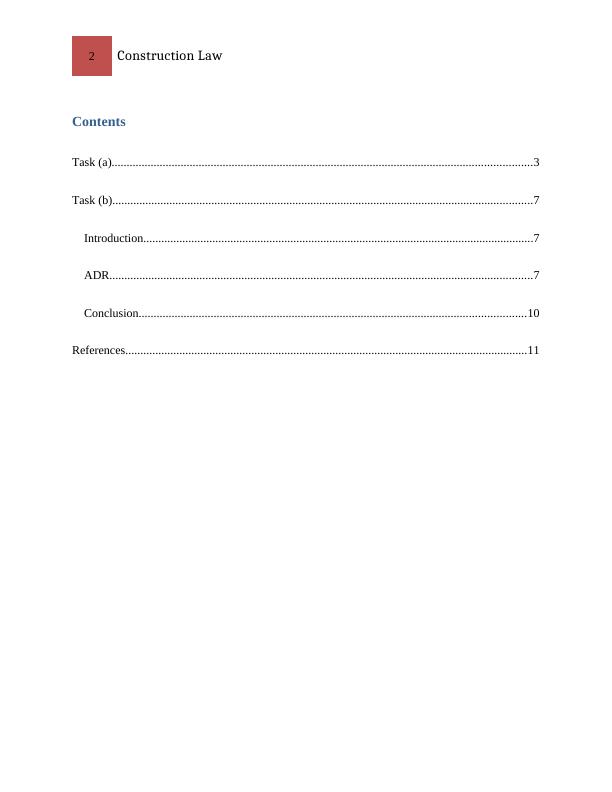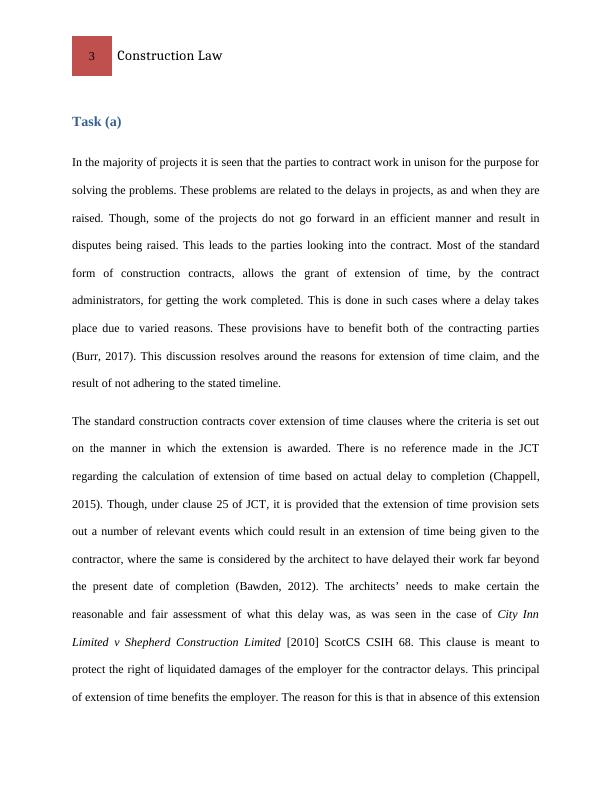Construction Law Assignment
13 Pages3263 Words337 Views
Added on 2020-04-15
Construction Law Assignment
Added on 2020-04-15
ShareRelated Documents

2Construction LawContentsTask (a)............................................................................................................................................3Task (b)............................................................................................................................................7Introduction..................................................................................................................................7ADR.............................................................................................................................................7Conclusion.................................................................................................................................10References......................................................................................................................................11

3Construction LawTask (a)In the majority of projects it is seen that the parties to contract work in unison for the purpose forsolving the problems. These problems are related to the delays in projects, as and when they areraised. Though, some of the projects do not go forward in an efficient manner and result indisputes being raised. This leads to the parties looking into the contract. Most of the standardform of construction contracts, allows the grant of extension of time, by the contractadministrators, for getting the work completed. This is done in such cases where a delay takesplace due to varied reasons. These provisions have to benefit both of the contracting parties(Burr, 2017). This discussion resolves around the reasons for extension of time claim, and theresult of not adhering to the stated timeline. The standard construction contracts cover extension of time clauses where the criteria is set outon the manner in which the extension is awarded. There is no reference made in the JCTregarding the calculation of extension of time based on actual delay to completion (Chappell,2015). Though, under clause 25 of JCT, it is provided that the extension of time provision setsout a number of relevant events which could result in an extension of time being given to thecontractor, where the same is considered by the architect to have delayed their work far beyondthe present date of completion (Bawden, 2012). The architects’ needs to make certain thereasonable and fair assessment of what this delay was, as was seen in the case of City InnLimited v Shepherd Construction Limited [2010] ScotCS CSIH 68. This clause is meant toprotect the right of liquidated damages of the employer for the contractor delays. This principalof extension of time benefits the employer. The reason for this is that in absence of this extension

4Construction Lawof time, the entitlement to employer to liquated damages can be delayed, where the delay is dueto default or prevention of employer (Farrell, 2010). Under the JCT contract, there is no express restriction under the contract on extension of timeclaim once the practical completion is done and it becomes difficult to find the implicit bar.Clause 2.7 has the closest provision where it is stated that when the delay becomes apparent, thecontract has to give notification to the contract administrator. This can be deemed as animmediate requirement; however, no consequence has been stated in the contract for failure innotifying the same immediately and even the courts are not likely to interpret this clause as beinga condition required for claiming relief (Thomson Reuters, 2012).Under clause 2.8, the contract allows the liquidated damages to be claimed by the employerduring any time till the issuance of final certificate. The guidance notes of the JCT to the contractprovide that the liquidated damages are not required to be taken into consideration by thecontract administrator for the purpose of calculation of any certificate. The employer has todeduct the same from the certified amount. It becomes difficult to ascertain why the contractpermits the employer to claim these damages once the practical completion is done without thecontractor being given a reciprocal right for claiming extension of time (Chappell, 2017). There are certain cases where the contractor would be entitled to an extension of time and thereare others where the same would be denied. For instance, in the case of Henry Boot Construction(UK) Ltd v Malmaison Hotel (Manchester) Ltd (1990) 70 ConLR32, QBD (TCC), Justice Dysongave an effective approach which is followed till date. This case stated that where the contractwas silent regarding the entitlement of the contractor to the extension of time, particularly whenthere was a concurrency in between the employer risk event and the contractor risk event, where

End of preview
Want to access all the pages? Upload your documents or become a member.
Related Documents
Construction and Building law PDFlg...
|11
|2163
|186
Assignment on Construction Lawlg...
|5
|969
|59
Construction Contractslg...
|4
|562
|411
Construction and Property Law - PDFlg...
|13
|2465
|67
JCT suit 2016 Construction law Name of the Student Name of the University Author Note A The JCT suit 2016 Construction Law Name of the Student Name of the University Author Note Alg...
|10
|2414
|172
The JCT Standard Building Contractlg...
|5
|743
|172
